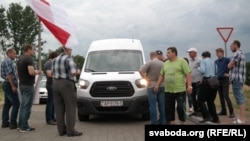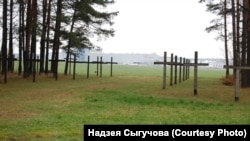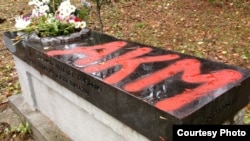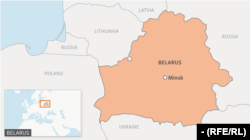Wooden crosses are scattered among the fir trees in this verdant patch of land outside the Belarusian capital, Minsk.
They commemorate up to a quarter of a million people who perished here, shot dead by the dreaded Soviet secret police from 1937 to 1941 during Stalin's Great Terror.
Seven decades later, Kurapaty has also become a place where people can "Let's Go And Eat," sparking outrage among activists and Belarusian citizens who see the nearby opening of a restaurant by that name as a disrespectful attempt to erase the past.
To Belarusian Nobel laureate Svetlana Alexievich the restaurant, located just dozens of meters away from the hallowed national heritage site, shows how low one can go.
"It's the absolute collapse of society," Alexievich told RFE/RL's Belarus Service.
"We allowed this to happen. Why is society quiet? In any European country there would be hundreds of thousands on the streets," Alexievich added indignantly.
The eatery opened after Belarus authorities redrew the historical site's borders in 2012, shrinking its size and opening up contiguous land for commercial activity.
Activists have been picketing the site since the restaurant opened in early June, but their numbers are low.
Forgotten Tragedy?
For many Belarusians, especially among the younger generation, memories of what happened at Kurapaty have vanished.
Interviewed recently by RFE/RL's Belarus Service on the streets of Minsk, few of those approached were informed about what took place there.
Critics say that's largely down to President Alyaksandr Lukashenka, who has often whitewashed Soviet crimes as the country he guided out of that era has carried on many legacies of communism.
Lukashenka said in April that the issue of Kurapaty had been "politicized."
"People who lie there want peace. They do not need this [controversy] dancing on their bones," he said.
Individuals and groups sympathetic to the Lukashenka government have confronted the protesters at the restaurant, including leather-clad bikers.
This is not the first time Kurapaty has been at the center of controversy. In the early 2000s, there were protests over nearby road construction plans. In 2017, plans to build a business complex were scrapped after outcries.
What Happened At Kurapaty?
Historians say that between 1937 and 1941, a period of mass killings and political persecution, the NKVD carried out large-scale executions in the wooded lands of Kurapaty.
The tragedy remained shrouded in Soviet secrecy until 1988, when a Belarus historian and one of the founders of the opposition Belarusian Popular Front party exposed what had happened.
Appearing during the Glasnost era under Mikhail Gorbachev, an article by Zianon Pazniak in the Litaratura i mastactva newspaper sparked some of the first protests in the Soviet Union and gave a boost to the pro-democracy and pro-independence movement in Belarus in the waning days of the U.S.S.R.
An investigation conducted from 1988 to 1995 established that Kurapaty contained the remains of 220,000 to 250,000 people, who were identified as victims of Stalin`s political terror.
Instead of embracing the findings, Minsk tried to downplay them and muddy the waters over who was responsible.
A government commission later revised the figure of victims first to 30,000 and then to 7,000.
Officials also claimed it was impossible to establish whether those buried there were victims of Stalin's purges or of Nazi Germany.
Despite government reluctance, Kurapaty was recognized as a historical site in 1993 with its status further cemented in 2004 when it was added to the register of Cultural Properties of Belarus.
'Campaign Of Silence'
With its status secured, crosses and other markers to commemorate the victims were erected at Kurapaty; however, they became the target of vandals.
The so-called Clinton Bench, a monument donated by U.S. President Bill Clinton during his visit to Belarus in 1994, was destroyed in the summer of 2001. It was rebuilt in early 2002, but heavily damaged again in May 2003 and in 2012.
In the latest incident at the site, vandals broke and knocked down crosses on June 13.
Independent historians and politicians are convinced that the Minsk authorities are bent on whitewashing the crimes of the Stalin regime, and that Kurapaty serves as an irritating reminder of its cruelty.
"There is a campaign of silence around a part of history of the Belarusian nation, the Belarusian people.It has been factually documented that this was a place of executions and, as such, it should be a place of remembrance and grief," said Hanna Kanapatskaja, one of two opposition parliamentary deputies in the Belarusian House of Representatives.
Building On The Graves of Stalin's Victims?
In 2001-2002, there were protests over the extension of the Minsk ring road not far from the Kurapaty site led by Belarusian opposition groups and NGOs.
In November 2001, the authorities sent riot police and bulldozers to tear down a tent camp set up near Kurapaty by young people from the Youth Front and Zubr groups.
Years later and closer to the actual Kurapaty site, plans were hatched to build an entertainment complex, Bulbash Hall, again igniting protests when construction got under way in 2010. (To add insult to injury, the word "Bulbash" is an epithet for Belarusians.)
"In 2012, the Minsk city prosecutor's office issued a ruling according to which four buildings of the then Bulbash Hall were to be demolished," explains Pavel Sevyarynets, one of the leaders of the protests at Kurapaty who was briefly detained by police on June 6.
A year later things were reversed, Sevyarynets explains, with the site seriously circumscribed when its official limits were redrawn.
The Let's Go And Eat restaurant is part of that abandoned entertainment complex, which includes a playground, cabins with saunas, and other accommodations.
Plans to build a business complex at another location adjacent to Kurapaty were abandoned in February 2017 following protests.
Amid the outrage, Lukashenka chimed in, announcing in early 2017 that a significant memorial would be erected at Kurapaty.
"It may be something like a chapel," he said.
A decision to build a memorial at Kurapaty was made by the government as far back as 1993, but was never implemented.
"They want to put a stone at Kurapaty," Alexievich said. "And it seems to them that in this way they will receive an 'indulgence' for such things to happen again."
Kanapatskaya says Lukashenka needs to send another message.
"It is incumbent on those government officials, those authorities who took it upon themselves to change the boundaries of the protected zones to make it clear, especially to businesses, that they themselves are responsible for the current mess."















